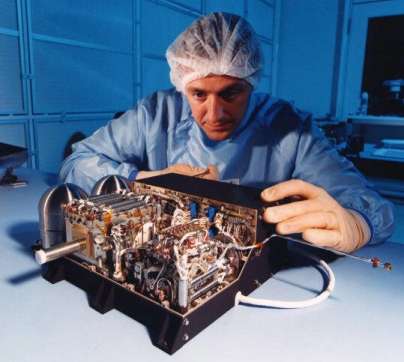|
|
|
| Diagnostics | |
Cometary spectrometer targets tuberculosis8 October 2007 A miniature mass spectrometer system, designed for the analysis of samples of a comet on the European Space Agency Rosetta mission is being adapted into a cost-effective, rapid and accurate tool for diagnosing tuberculosis (TB). The Wellcome Trust has awarded scientists at The Open University and the London School of Hygiene and Tropical Medicine (LSHTM) £1.34 million to develop the mass spectrometer into a disease-detecting tool. The disease, which is caused by the M. tuberculosis bacterium, is thought to kill two million people every year, primarily in the developing world, and is now on the rise in developed countries. The mass spectrometer will be capable of detecting TB in samples of sputum much quicker and with a much greater sensitivity than current methods. The project was unveiled last week at the University of Manchester’s Jodrell Bank Observatory as part of celebrations to mark the 50th anniversary of the launch of Sputnik. The spectrometer was designed for the Beagle 2 mission to mars and the Rosetta space mission that will land on comet Churyumov-Gerasimenko in 2014.
Professor Keith Mason, CEO of the Science and Technology Facilities Council said, "This provides a clear demonstration of how investment in space can lead to advances in technologies which have direct benefit to humankind. It is fantastic to think that technologies that are currently on their way to a distant comet will be helping people here on Earth." The research team is led by Dr Geraint "Taff" Morgan and Professor Colin Pillinger at the Open University, who developed the instrumentation for the Beagle 2 mission and the Rosetta lander, together with Dr Liz Corbett from the LSHTM. Dr Morgan said: "The thing with developing technology for space missions is that if forces you to push boundaries and think outside the box when you're looking for new solutions to challenging problems. Many of the technical challenges we have overcome in designing our space instruments are the same as we face with this issue." At present, TB in resource-poor settings relies mainly on the use of smear microscopy of sputum samples, a very labour-intensive process with low sensitivity. Dr Morgan said: "Smear microscopy is not a very accurate way of diagnosing TB and only detects a third of all positive cases. That means seven out of ten patients will effectively need to get worse before they can be diagnosed and treated. Clearly, we need a new solution to this problem.” Dr Morgan believes that the answer lies with a shoe-box sized gas chromatograph mass spectrometer (GC-MS), known as Ptolemy, carried by the Rosetta lander. The European Space Agency’s Rosetta spacecraft will land on comet Churyumov-Gerasimenko in 2014, where it will analyse the chemical composition of samples from the comet’s nucleus. "Chemicals have their own unique 'signature'," says Dr Morgan. "The bacterium that causes TB has a special coating and it is the pattern of chemicals in this coating that the mass spectrometer will be 'searching' for." The GC-MS is fully automated, so does not require skilled laboratory technicians or special laboratory facilities. This means that the technology will be more widely available in the places that need it most. The Wellcome Trust, the UK’s largest medical research charity, funded development of the original mass spectrometer on the Beagle 2 mission to Mars. Professor Colin Pillinger, the driving force behind the mission, has praised the Trust's vision. "The Wellcome Trust had the foresight to see that the miniaturisation process needed to develop a mass spectrometer capable of fitting onto a spacecraft could have applications far closer to home," says Professor Pillinger. "It is very rewarding to see such vision paying off in clinical research."
|
